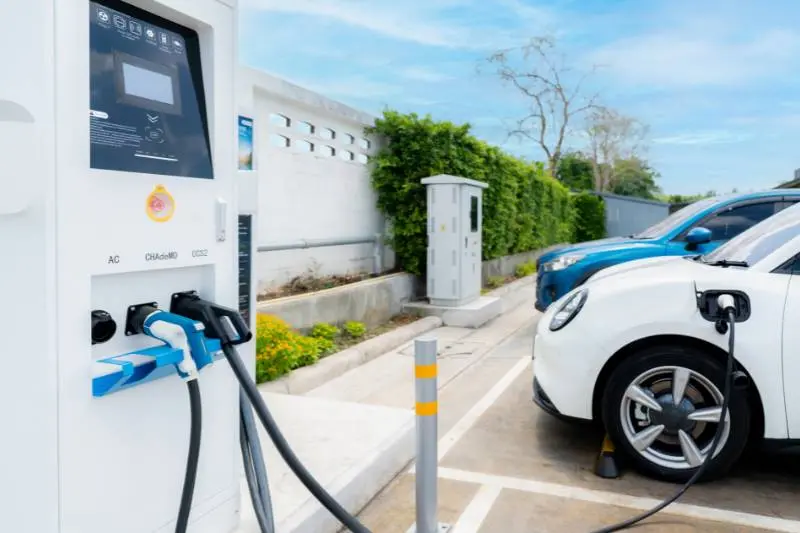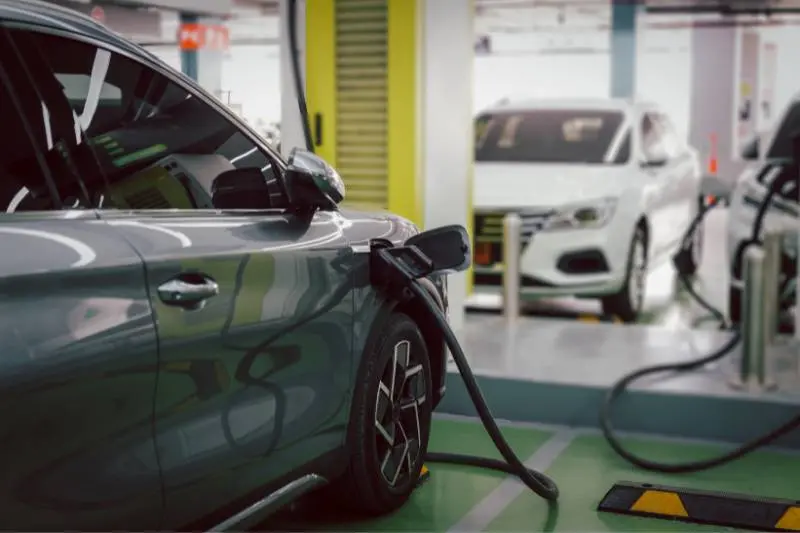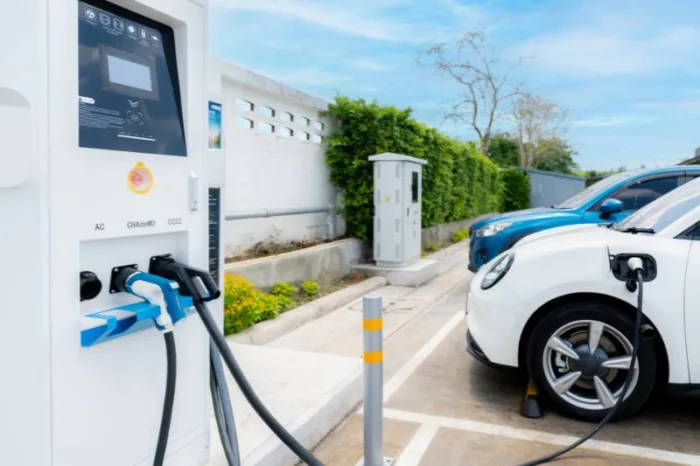Key takeaways
- The challenges of EV charging are meeting growing demand across the U.S. within the next few years.
- Renters can only charge their EVs by using public charging stations, installing an EV charger at a personal garage, or advocating for their apartment to install chargers.
- EV charging for apartments is beneficial in many ways, such as being an attractive amenity, helping the environment, and adding a source of revenue.
- Some drawbacks of EV charging for multifamily properties are their high upfront costs, legal and liability challenges, and space and parking allocations.
- The cost of EV charging for apartments is influenced by hardware, installation, infrastructure, software, and soft costs.

As electronic vehicles become ubiquitous, apartment EV charging will grow in demand as a multifamily amenity. Both condos and apartments can leverage EV charging stations as an attractive property feature, but is it worth the investment?
Well, this guide will cover the challenges of EV charging and how residents can charge their electric vehicles without on-site stations. Additionally, you’ll learn the pros and cons of installing charging stations on your multifamily property before breaking down the costs. Most importantly, you will find the best apartment EV charging solutions.
This guide covers:
- Challenges of EV charging
- How do you charge an EV if you live in an apartment?
- Pros and cons of EV charging stations for apartments
- Costs of installing EV charging stations for multifamily properties
- Best EV charging stations for apartments
Challenges of EV charging
When it comes to the number of electric cars in the U.S., there are approximately three million on the road. Simultaneously, almost 39 million Americans live in apartments. So, as demand for electrical vehicles increases among renters, so does the need for charging stations at apartments.
Of course, most apartment dwellers with electric vehicles rely on public charging stations. However, public EV charging is not as prevalent as the demand requires. To rectify this problem, the United States must add four times the number of existing EV chargers to meet expected demand by 2025.
However, apartments and condos can help meet demand by installing EV chargers for their residents. Not only will it attract residents, but it also opens up a new source of income while giving peace of mind to EV owners.
How do you charge an EV if you live in an apartment?
Renters face many limitations when it comes to EV charging options at apartments. Fortunately, there are a few ways to work around these hurdles. Not to mention, some states make it easier for renters to charge EVs at their apartments.
The methods to charge an electric car at an apartment include:
- Use public charging stations. The most obvious solution is to charge an EV at a public charging station. Of course, public charging is not ideal because it may not be widely available in an area. Not to mention, it requires a significant amount of time and typically costs more than charging at home.
- Install EV charging at a personal garage. If you own or rent a personal garage, install an EV charging station to take advantage of at-home charging. If your apartment offers garage spaces, reach out to management to discuss EV charging installation options. Otherwise, an off-site garage is an option. Unfortunately, an off-site garage poses a similar disadvantage as public charging in that it requires time out of your day away from home.
- Advocate for EV charging at apartments. Reach out to other residents in your apartment who own electric vehicles. Then, work together to advocate for EV charging stations. Go to property management with a letter, resources on the topic, and additional information to back your goal. Ideally, property management will hear the community out and consider the option. In most states, the decision to install EV charging comes down to the property owner or management. However, some states, like California, give tenants the right to install electric vehicle charging stations at their apartments if they are willing to pay for installation fees.
Can I install a Tesla charger in my apartment?
You may only install a Tesla charger in your apartment with the property’s permission. So, reach out to the property manager or owner to start conversations.
How do I charge my Tesla if I live in an apartment?
Public charging stations are the best solution for charging your Tesla when living in an apartment.
On the other hand, you can work closely with your apartment complex to install communal EV charging stations. As stated above, the decision to install the charging stations comes down to the property, but it’s best to bring them the idea so they know residents’ needs.
Additionally, if your workplace has charging stations, use them throughout the week. That way, you can reduce your need for public EV charging.
Learn how to create an eco-friendly living experience:
Pros and cons of EV charging stations for apartments
For property managers or owners, apartment EV charging stations could serve as a beneficial amenity but also have their own drawbacks. Here is what you need to know when it comes to the pros and cons of apartments with EV charging.
Pros of apartment EV charging stations
- Attractive amenity. EV charging stations for apartments are not currently a commonly available amenity at multifamily properties. So, by installing EV charging at your property, your community becomes more attractive to potential residents. Keep in mind EV charging is a growing apartment trend, so get ahead while you can.
- Environmental benefits. Electric cars produce fewer greenhouse gases, meaning EV charging stations bolster your property’s green initiatives. This is especially beneficial when looking to attract eco-conscious residents.
- Increased property value. Prospective buyers or investors may find EV charging stations as a unique amenity, increasing the value of the property.
- Source of revenue. You can charge residents to use the apartment EV charging stations for an additional source of revenue. Plus, some charging stations support billing and payment management directly.
- Government incentives. Depending on your location, you could benefit from government incentives to help offset installation and maintenance costs. Check your local jurisdiction for details.
Cons of apartment EV charging stations
- Upfront costs. Hardware for DC fast chargers, the fastest commercial EV charger, ranges from $10,000 to more than $40,000 for hardware alone. Not to mention, installation and construction costs quickly add up.
- Ongoing maintenance. EV chargers require regular maintenance and upkeep to provide a reliable service. Of course, not just any electrician can help maintain your property’s EV chargers. Instead, a certified technician is required to work on your specific brand of chargers. So, you could be left with lengthy downtimes if there aren’t enough technicians available.
- Problematic infrastructure. The age and infrastructure of your building will have an impact on EV charging installation. For instance, a property’s electrical systems may not be strong enough to support charging stations. Thus, you’ll be required to make upgrades, which further increases costs.
- Space and parking allocation. EV charging stations require a significant amount of space to be effective. What’s more, charging stations cut down on parking. Thus, multifamily properties with limited space, such as those in downtown areas, will find it difficult to implement charging stations.
- Legal and liability challenges. Before ever installing apartment EV charging, your property must organize legal and liability issues. These issues include terms of use, insurance coverage, and municipal compliance.
Costs of installing EV charging stations for multifamily properties
The cost of installing commercial EV charging stations can range anywhere from $1,500 to more than $40,000 per charger. Of course, many factors will influence the costs.
Costs of EV charging stations for multifamily properties are influenced by the following:
- Hardware. EV charging stations come in three different power levels: level 1, level 2, and level 3 — also known as DC fast chargers. The level of charger you select will impact the price, with each subsequent level being more expensive than the last.
- Installation. Costs related to installation depend on the company you hire and the complexity of the installation. If your property is not designed in a way where installation is straightforward, expect higher costs.
- Infrastructure. Many buildings lack the modern infrastructure to support commercial EV charging stations because of the additional load they add to the electrical system. Thus, many buildings must upgrade if they wish to add electrical vehicle chargers.
- Software. EV charging stations require robust software solutions to manage their power network, customer payments, and more. So, keep in mind any potential recurring fees associated with EV charging station software.
- Soft costs. Lastly, soft costs refer to any costs outside of the physical construction process, such as building permits, marketing, and insurance.

Best EV charging stations for apartments
EV charging stations may seem like a niche market, but there are many companies offering their solutions.
Here are the three best commercial EV charging station companies:
1. ChargePoint
Founded in 2017, ChargePoint has an expansive network of customers and chargers. In fact, someone plugs into the ChargePoint network every second. Not to mention, 76% of Fortune 50 companies are ChargePoint customers.
With that said, ChargePoint offers a wide range of EV charging solutions geared towards various apartment configurations: assigned charging, community charging, and mix-use charging. Above all, their EV charging stations are backed by powerful software for easy management.
Features:
- Single and dual charging stations.
- EV charging software delivers insights into usage, sustainability, and more.
- Manage EV stations remotely.
- Power management software manages power intelligently to maximize the number of stations.
- More than 40 third-party integrations supported.
- Control pricing and availability schedules from the software.
2. EVBox
Since 2010, EVBox has shipped more than 500,000 charging ports worldwide, accumulating more than 20,000 commercial customers. EVBox is behind an award-winning charging station design that’s ADA-compliant, features a large touchscreen display, and LED lighting for easy guidance.
Furthermore, the EVBox Iqon is designed to withstand exterior conditions, ranging from severe weather to potential vandalism. That way, up to two residents can charge their electric vehicles simultaneously at 7.2 kW per car.
Features:
- ADA-compliant and wheelchair accessible.
- Universally compatible with every EV available.
- 8” LCD touchscreen displaying instructions, pricing, supported languages, and more.
- Auto-retractable cables.
- Supports two EVs at the same time.
3. Orange
Unlike other apartment EV charging options, Orange has developed a smart outlet capable of providing the same solution at a lower cost. The Orange outlet is specifically designed for apartment buildings, allowing it to be installed throughout parking garages and areas.
Additionally, Orange has a robust OS, so properties can easily manage all of their outlets through one platform. Orange OS gives insights into charging sessions, energy usage, rates, and more. Most importantly, Orange outlets can be managed from a mobile app.
Features:
- Outlets can last more than 10,000 plug-in cycles.
- 120 and 240-volt variations.
- Manage and track payments with Orange OS.
- Orange OS manages all outlets you may have on your property.
- Set rates or schedule time-of-use increases.
- Built-in LED details outlet’s status.
- QR code grants access to charging.







